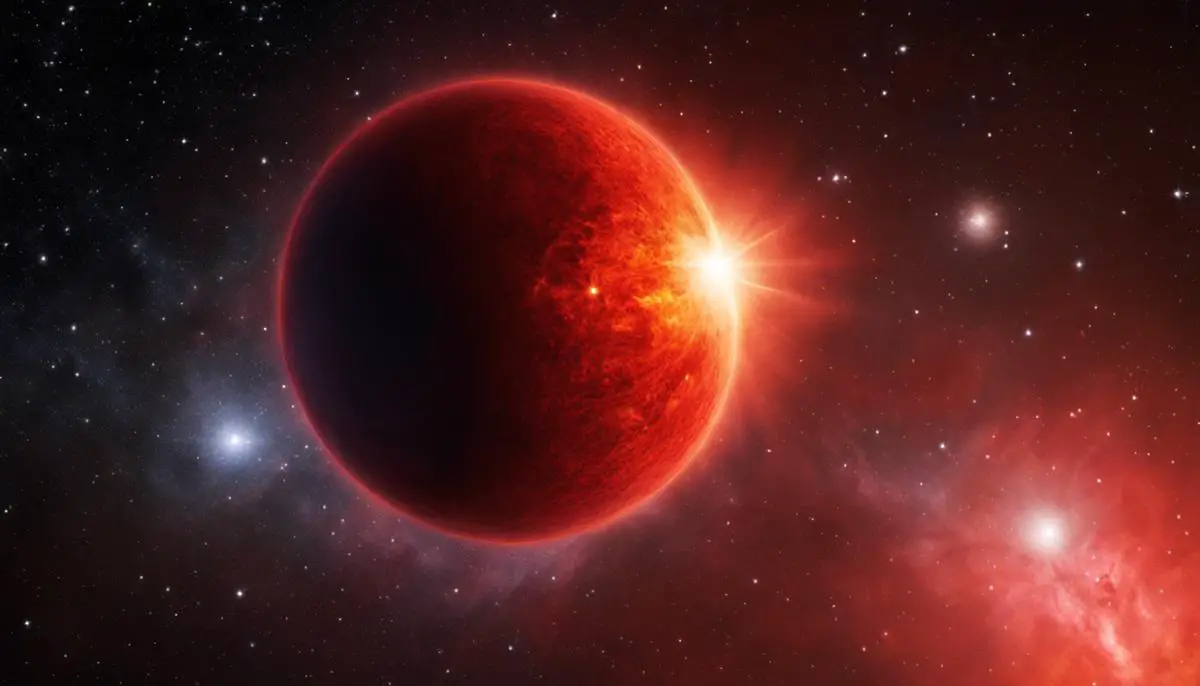The celestial bodies that populate the night sky hold a profound allure, characterized by their mystifying glow and enormity. Among these, the star Betelgeuse, lying in the Orion constellation, is particularly intriguing due to its daunting size and distinctive features. As a red supergiant, it dwarfs our solar system’s Sun in a comparison that borders on incomprehensible. The Sun, a familiar celestial neighbour, offers a standard for stellar comparisons, providing the astronomical community with a concrete point of reference both in size and luminosity. This exploration aims at comparing these celestial bodies, presenting a detailed analysis of their sizes and the implications of their dimensions on other key characteristics.
Understanding Betelgeuse
Betelgeuse hails from the prominent constellation of Orion and is classed as a red supergiant. Its status as the latter places it in a very select and unusual class of stars. To understand Betelgeuse, one must delve into the depths of stellar metamorphosis, the life cycle of stars, and the incredible expansiveness of celestial magnitudes.
In its infancy, Betelgeuse was not so different from our sun, a ball of quickly-fusing hydrogen. However, unlike our sun, Betelgeuse’s initial mass dwarfed ours by at least a factor of eight. This increased mass leads to an increased fusion rate and puts the star on a divergent evolutionary path than ‘standard stars’.
In the heart of Betelgeuse, helium and carbon atoms forged through nuclear fusion tumble one after another into higher elements. It has exhausted its initial hydrogen and expanded dramatically into a red supergiant, a stage our sun will not attain for another five billion years.
The inconceivable size of Betelgeuse truly sets it apart from other known celestial objects, thus placing it in the extreme on every scale. If placed at the center of our solar system, Betelgeuse would extend beyond Jupiter, engulfing Mercury, Venus, Earth, Mars, and the asteroid belt in a fiery, atomic maelstrom. Compared to one of the most familiar stars – our sun, Betelgeuse’s radius is approximately 900 times larger.
Further setting Betelgeuse apart from standard stars is its variability. Betelgeuse pulsates over a roughly 400-day period, causing its visible magnitude to fluctuate between 0.2 and 1.2. This variability is another fingerprint of its advanced age and evolved status.
But perhaps the most exciting difference lies in the inevitability of Betelgeuse’s spectacular demise. As a red supergiant, Betelgeuse is marching inexorably towards an explosive end as a supernova. When this celestial event occurs, it will outshine every star in the Milky Way and become one of the brightest objects in our night sky.
The study of stars like Betelgeuse allows for deeper insight not just into the universe’s esoteric mechanisms, but also illuminates the future of stars closer to home, such as our sun. The field of stellar physics continues to evolve, much like the stars it seeks to understand, and a continual feast of knowledge opens up with every new discovery. This vast understanding is driven by the curiosity, passion, and meticulous examination of the cosmos. It is only through diligent observation and scientific scrutiny that the story of celestial bodies like Betelgeuse can be gradually unraveled, ultimately contributing to the grand tapestry of knowledge about the universe we inhabit.
Through the prism of scientific analysis, Betelgeuse is so much more than just a pinpoint of light in the night sky. It is an embodiment of the magnificent, destructive, and incessantly surprising nature of space, offering valuable insights into the life and death of stars.
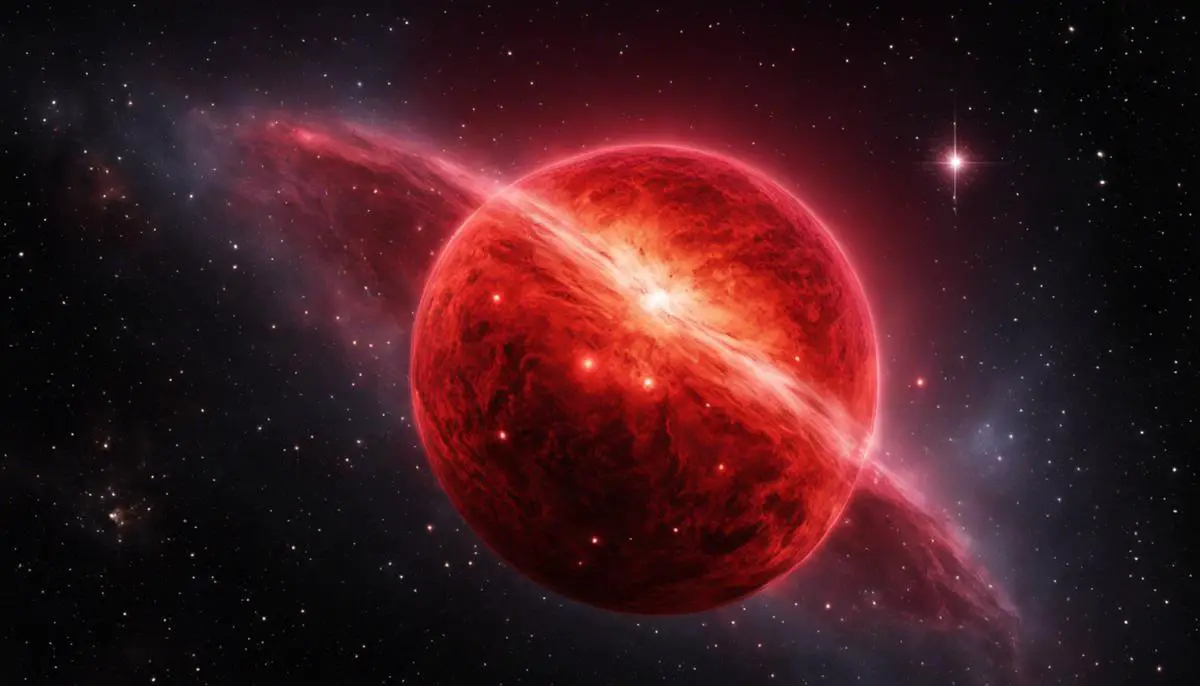
Sun- a stellar benchmark
Continuing the in-depth exploration of celestial bodies, analyzing the Sun as an established measurement unit for stars offers a compelling method of assessing otherstellar phenomena. Prima facie, the Sun, the nearest star to Earth, provides an immediate point of reference, making it instrumental in comparing varying stellar characteristics.
In stellar astrophysics, the Sun often becomes a yardstick, given its proximity. Its physical attributes, therefore, form the base for standardized solar units used to comprehend other celestial entities with more practicality. For instance, the solar radius and solar mass are universally recognized units of measurement. Stars, including Betelgeuse, are often equated in terms of ‘solar radii’ or ‘solar masses’ to elucidate scope and size. The concept of ‘solar luminosity’- the total amount of energy emitted by the Sun per unit time, additionally, provides a baseline for estimating the luminosity, and thus the energy output, of other stars.
Radii, mass, and luminosity are undoubtedly crucial, but spectral class is another discerning factor where the Sun takes center stage. Classified as a G-type main-sequence star (G dwarf), the Sun helps in characterizing the surface temperature of other stars. With its temperature marked at 5,500 degrees Celsius, other stars are denoted as ‘hotter’ or ‘cooler’ in comparison, significantly vital for understanding the chemical processes happening within.
The Sun further serves as a calibration point in the Hertzsprung-Russell (HR) diagram, a pivotal tool in stellar astrophysics. Serving as an efficacious map in predicting star life cycles, the HR diagram chronicles the Sun’s progression from a main-sequence star, offering an exemplary reference for identifying and anticipating the evolutionary path of stars like Betelgeuse.
Understanding solar wind – a stream of charged particles released from the Sun’s surface – is undeniably critical for building models to estimate the stellar wind and mass loss rates from evolved stars. As the Sun’s solar wind impacts Earth’s magnetosphere, causing polar auroras, parallel deductions for red supergiants and how stellar winds could influence surrounding cosmic environments have become achievable.
In summary, with the Sun as a comparative model, it enables the demystification of stellar astrophysics’ complex nature, the AEgIS of which brings other cosmic entities, including the enigmatic Betelgeuse, into a more distinct, comprehensible perspective. While the universe’s sheer vastness renders our knowledge fractional, every new grasp upon our known cosmic vicinity helps shed light on the remaining, uncharted darkness. Thus, the Sun’s usage as a stellar measurement unit underscores its quintessential role in marching towards a more illuminated understanding of our vast universe.
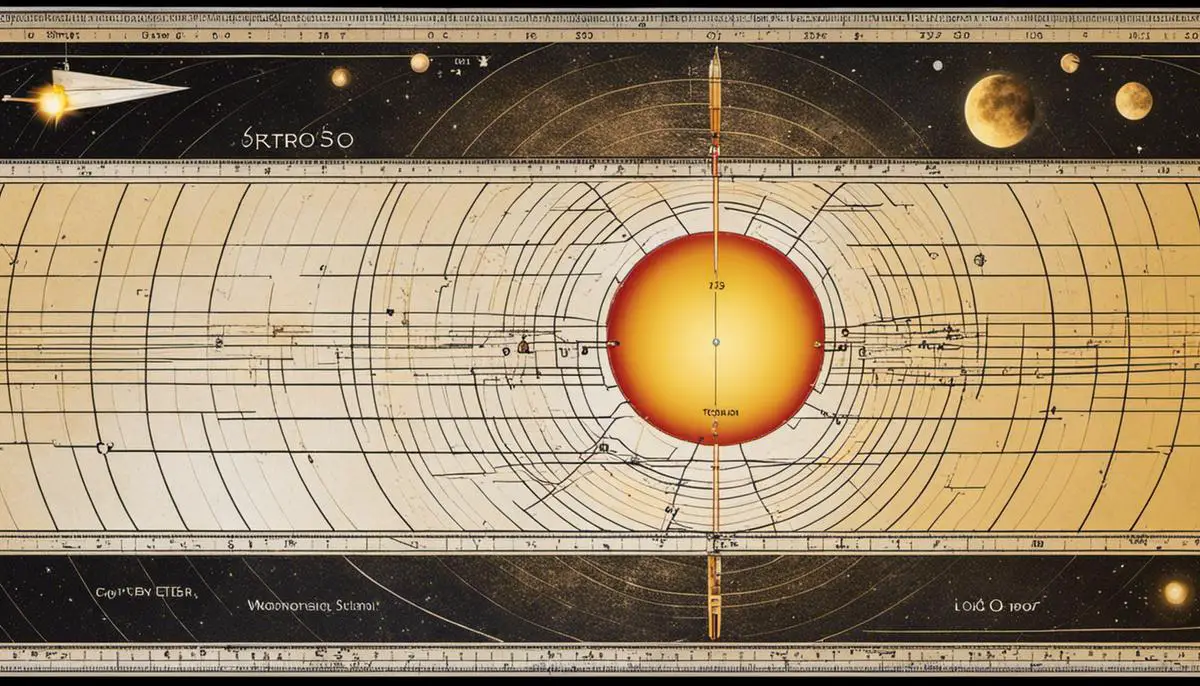
Comparative Analysis of Betelgeuse and the Sun
To start the discourse on the comparison between Betelgeuse and the Sun, it becomes necessary to comprehend the incredible diverse nature of our universe. Betelgeuse and the Sun, both stellar constituents of our cosmos, present an intriuging comparison due to their vastly different characteristics.
Every star, including our Sun, has a radius. This value, known as solar radius, has been standardized as approximately 696,340 kilometers, and is widely accepted as a unit of measurement when rendering the proportions of other celestial bodies. Gray (2008, p.1) affirms that Betelgeuse surpasses the Sun in radius tremendously. If it were positioned at the center of our solar system in the place of our cherished Sun, its outer surface would reach beyond the asteroid belt, possibly nearing Jupiter’s orbit – that is beyond Mars. This indicates that Betelgeuse dwarfs the Sun over 700 times in diameter and over a whopping 300 million times in volume.
Notably, stars vary significantly in mass as well. The Sun, with its defined solar mass equal to about 1.989 × 10^30 kilograms, again serves as a benchmark. As per the research of Dolan (2016, p.4), Betelgeuse estimated mass is around 20 times of solar mass, which influences its vastly different life cycle due to more rapid burning of its nuclear fuel.
Determined by temperature, each star is classified into a spectral type. While the Sun falls under the classification G2V, indicating that it is a yellow dwarf, Betelgeuse is classified as an M1-2Ia-Iab type, communicating that it’s a red supergiant. Hence, while our Sun has an effective surface temperature of around 5,500 degrees Celsius, Betelgeuse has a much cooler surface temperature, with estimates swaying between 3,200 and 3,500 degrees Celsius.
Furthermore, solar luminosity, the total amount of energy emitted by the Sun per unit time, serves as a standard unit to measure the illuminating power of stars. In this regard, Betelgeuse outshines our Sun substantially, with a bolometric luminosity approximately 120,000 times that of our home star.
The Sun’s lifecycle, whilst used as a reference, is also considerably different from Betelgeuse’s due to their size difference, leading to the red supergiant’s shorter lifespan and dramatic end as a supernova. Conversely, our Sun, being a medium-sized star, will quietly shrivel into a planetary nebula leaving behind a white dwarf.
An examination of the Sun’s solar wind is crucial to understanding its influence on Earth’s magnetosphere. However, the colossal Betelguese’s stellar wind and mass loss rates are more challenging to estimate. This remains a pivotal area of research in stellar physics and is consequential since these factors may greatly influence the timing of Betelgeuse’s impending supernova event.
Finally, it is through the comprehensive knowledge of our Sun and the invaluable comparison it provides that we can further explore the cosmic entities around us. The mysteries of our universe, including puzzling giants like Betelgeuse, become less elusive when their idiosyncrasies are studied against our intimate knowledge of the Sun. This exploration continues to yield new insights about our universe and, unequivocally, our place within it.
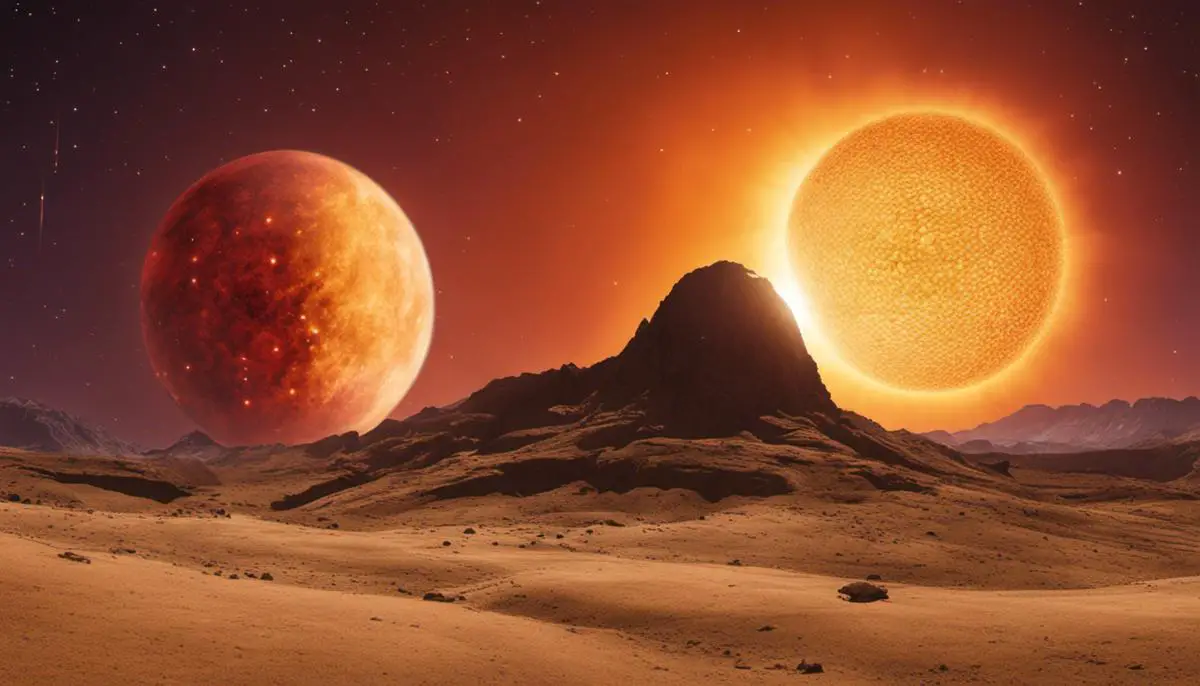
Observable Implications of size difference
Though we have delved into the intricacies of our subject, the enormous size of Betelgeuse compared to the Sun, we have remained somewhat adrift. One key discrepancy is the gravitational effects embedded in the massive structure of Betelgeuse. Given its vast size, it is no surprise that the gravitational pull of Betelgeuse far surpasses that of the Sun. This gravitational intensity has notable implications for any potential orbiting bodies within its gravitational reach, which, due to the star’s immense dimensions, is likely a considerably broad area.
By their essence, larger stars are more prone to substantial and rapid mass loss, primarily through stellar winds. These winds carry away a significant fraction of a star’s mass, with stronger winds for larger stars. Consequently, giants like Betelgeuse lose mass at a higher rate than our Sun. This mass loss significantly influences their lifetimes and eventual supernovae events.
The photosphere, or visible ‘surface’ of Betelgeuse, has been extensively studied due to its imposing size, with surface features discernable through observational techniques. Unlike the near spherical Sun, Betelgeuse’s gigantic size leads it to an oblate form, where it is more extended around the equator than along the poles. This shape lends itself to the star’s pulsating nature, causing periodic, observable changes in the star’s brightness and size.
Additionally, the sheer size of Betelgeuse provides an unprecedented opportunity to study convection processes. Convection, crucial for heat transfer in both Sun and Betelgeuse, operates vastly different in red supergiants, primarily due to their extensive atmospheres. Observing these processes in a star as large as Betelgeuse provides crucial insights into convection mechanics in stellar atmospheres.
Furthermore, the extensive size of Betelgeuse compared to the Sun materially affects the scale of the anticipated supernova event. While the Sun, upon reaching its evolutionary end will swell into a manageable red giant and shed its outer layers gently into space, Betelgeuse’s spectacular finale will be an explosion of astronomical proportions, leaving a neutron star or a black hole in its wake. This cataclysmic event, fueled by the star’s massive size, paves the way to investigate phenomena such as neutrino emission in supernovae, the creation of heavy elements, and the interstellar medium’s subsequent enrichment.
Lastly, Betelgeuse’s size and imminent end don’t merely fascinate, they illustrate a poignant truth about astronomical bodies: their sheer scale, breathtaking beauty, and ultimate solitude in the vast theater of the cosmos. This introspection further amplifies the profound significance of these celestial behemoths in shaping our understanding of the cosmos, encapsulating our continual journey of cosmic exploration. After all, in the quest to unravel the mysteries of the universe, there is as much to glean from these silent, singular giants as there is from a bustling mass of the milky way.
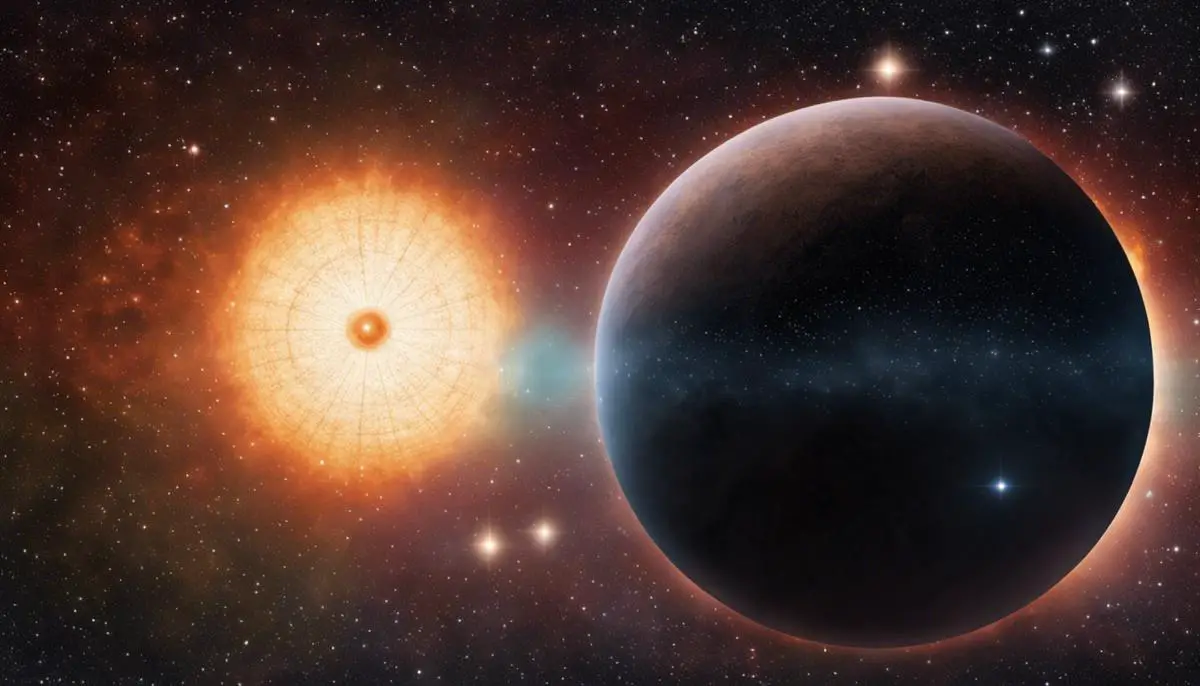
This exploration has shed light on the staggering realities of the cosmos, underscoring the vastness of Betelgeuse compared to our Sun. By understanding the remarkable size disparity, we can envision the corresponding variations in temperature, luminosity, and lifespan. Moreover, a hypothetical scenario, wherein our Sun swells to the size of Betelgeuse, helps to further cement these concepts in our minds. It is through such comparative studies that we can grasp the awe-inspiring nature of our universe, revealing a deeper understanding of our own Sun’s miniscule dimensions and the supreme grandeur of stellar giants like Betelgeuse.
FAQ
How big is Betelgeuse compared to the Sun?
Notably bigger than our Sun is Betelgeuse, a red supergiant star in the constellation Orion. The estimated diameter of Betelgeuse is nearly 1,000 times greater than that of the Sun, which has a diameter of roughly 1.4 million kilometers. Betelgeuse is one of the biggest stars known to science due to its enormous size. Betelgeuse is a pulsing star, thus precise measurements can vary significantly, but it is usually thought to be a big, bloated star nearing the end of its life. This size comparison demonstrates the remarkable range of sizes inside our cosmos and the enormous diversity in the magnitude of celestial objects.
How many suns could fit in Betelgeuse?
Betelgeuse is a massive red supergiant star in the constellation Orion, so massive that its bulk could hold an incredible quantity of Suns. It is estimated that the massive diameter of Betelgeuse might contain about 1.4 billion Suns arranged side by side. With a diameter about a thousand times greater than our Sun’s, this startling comparison highlights Betelgeuse’s enormous immensity. Betelgeuse is one of the biggest stars that is currently known to exist. Its size and variety demonstrate the amazing breadth and depth of the enormous cosmos.
Is Betelgeuse in the Milky Way?
Yes, Betelgeuse is indeed situated inside the Milky Way galaxy. In particular, it is a component of the constellation Orion, which is located in one of our galaxy’s spiral arms. Betelgeuse is one of the Milky Way’s most noticeable stars and is readily visible with the unaided eye in the night sky. Betelgeuse is a prominent star in our galaxy, a red supergiant that adds to the diverse array of celestial objects that cover the great majority of the Milky Way.
Is Betelgeuse bright or dim?
Betelgeuse is regarded as a brilliant star that is simple to see in the night sky with the unaided eye. Because it is a red supergiant, it is among the brightest stars in our galaxy. Betelgeuse is a brilliant star in the constellation of Orion, yet its brightness varies over time owing to pulsation. Betelgeuse outshines a lot of other stars in the night sky when it is at its brightest. It’s crucial to remember that Betelgeuse is renowned for its unpredictability; astronomers have taken notice of it when it has occasionally shown signs of fading. Betelgeuse continues to be a prominent and brilliant star presence in our cosmic neighborhood despite these variations.
Why did Betelgeuse go dark?
When Betelgeuse, the red supergiant star in the constellation of Orion, showed an unexpected dimming in late 2019 and early 2020, it garnered a lot of interest. This event led to conjecture and investigation into the causes of Betelgeuse’s transient fading. Astronomers think that the star’s massive dust outburst into space is probably what caused the dimming, though the precise cause is still up for debate. It’s possible that some of this ejected material covered Betelgeuse, making it look less bright from Earth. Red supergiants generally exhibit such changes in brightness, and Betelgeuse in particular is well-known for its pulsations and irregular cycles. Astronomers had a unique chance to examine the dynamics of big stars and their intricate life cycles, gaining understanding of the workings of these stellar giants, thanks to Betelgeuse’s dimming.
Is Betelgeuse a dying star?
Yes, at the latter stages of its life cycle, betelgeuse is categorized as a dying star. It has used up all of the hydrogen fuel in its core and is now in the red supergiant phase. Betelgeuse is presently among the biggest stars known to exist as a result of its massive expansion. This expansion is a forerunner to Betelgeuse’s final destiny because a supernova explosion is anticipated in the astronomically near future. Astronomers are intrigued by the star’s changing behavior, particularly its recent episodes of dimming, and this has contributed to the mystery surrounding Betelgeuse’s approaching transformation, even though the precise time of this event is yet unknown. As they release heavy materials created in their cores into space, large stars like Betelgeuse’s death throes contribute significantly to the formation of new stars and planetary systems, as well as to the enrichment of the universe.
![]()
